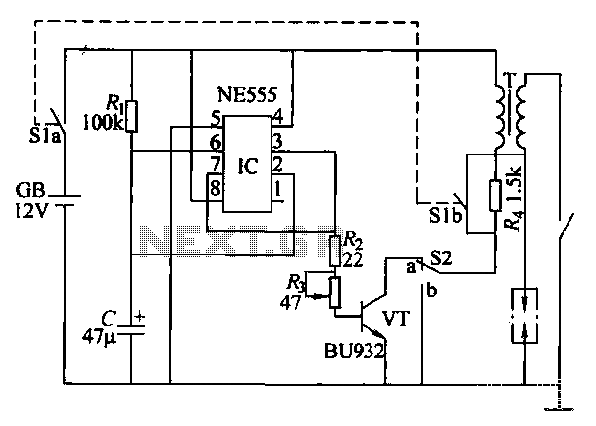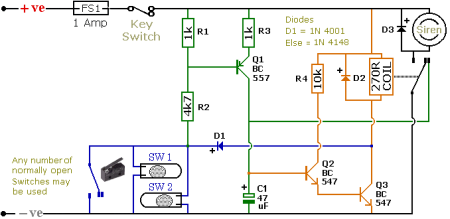
House Alarm Loop

This circuit features open and closed loop contacts (switches 1, 2, 3) that activate the alarm, which remains activated for 5 to 10 minutes. The triggering delay for entrance and exit is set to 27 seconds. Additionally, this simple alarm circuit includes a cancel button to reset the circuit back to standby mode.
The alarm circuit is designed to provide a reliable security solution using a combination of open and closed loop switch contacts. The open loop contacts serve as sensors that detect unauthorized entry, while the closed loop contacts can be used for various applications, such as monitoring doors or windows. When any of the switches (1, 2, or 3) are triggered, the circuit activates the alarm system, ensuring immediate notification of a potential security breach.
The alarm remains active for a duration of 5 to 10 minutes, allowing sufficient time for an individual to respond to the alert. This time frame can be adjusted based on specific requirements or preferences. The inclusion of a 27-second triggering delay for both entrance and exit provides users with a grace period to deactivate the alarm before it becomes fully operational, thereby reducing false alarms during regular access.
To enhance user control, the circuit is equipped with a cancel button. This feature allows users to reset the alarm system back to its standby mode, ensuring that the system can be quickly reactivated without the need for a complete power cycle. The cancel button is strategically placed for easy access, promoting user-friendly operation.
Overall, this circuit design combines functionality with simplicity, making it suitable for various security applications where timely alerts and user control are paramount. Proper implementation of this circuit can significantly enhance security measures in residential or commercial settings.This circuit offers open and closed loop contacts (switches 1,2,3) that triggers the alarm ON and stays ON for 5 -10 minutes. The trigering delay (entrance/exit) is 27 seconds. This simple alarm circuit Has also a cancel button for reseting the circuit to stand-by mode again.. 🔗 External reference
The alarm circuit is designed to provide a reliable security solution using a combination of open and closed loop switch contacts. The open loop contacts serve as sensors that detect unauthorized entry, while the closed loop contacts can be used for various applications, such as monitoring doors or windows. When any of the switches (1, 2, or 3) are triggered, the circuit activates the alarm system, ensuring immediate notification of a potential security breach.
The alarm remains active for a duration of 5 to 10 minutes, allowing sufficient time for an individual to respond to the alert. This time frame can be adjusted based on specific requirements or preferences. The inclusion of a 27-second triggering delay for both entrance and exit provides users with a grace period to deactivate the alarm before it becomes fully operational, thereby reducing false alarms during regular access.
To enhance user control, the circuit is equipped with a cancel button. This feature allows users to reset the alarm system back to its standby mode, ensuring that the system can be quickly reactivated without the need for a complete power cycle. The cancel button is strategically placed for easy access, promoting user-friendly operation.
Overall, this circuit design combines functionality with simplicity, making it suitable for various security applications where timely alerts and user control are paramount. Proper implementation of this circuit can significantly enhance security measures in residential or commercial settings.This circuit offers open and closed loop contacts (switches 1,2,3) that triggers the alarm ON and stays ON for 5 -10 minutes. The trigering delay (entrance/exit) is 27 seconds. This simple alarm circuit Has also a cancel button for reseting the circuit to stand-by mode again.. 🔗 External reference
Warning: include(partials/cookie-banner.php): Failed to open stream: Permission denied in /var/www/html/nextgr/view-circuit.php on line 713
Warning: include(): Failed opening 'partials/cookie-banner.php' for inclusion (include_path='.:/usr/share/php') in /var/www/html/nextgr/view-circuit.php on line 713





